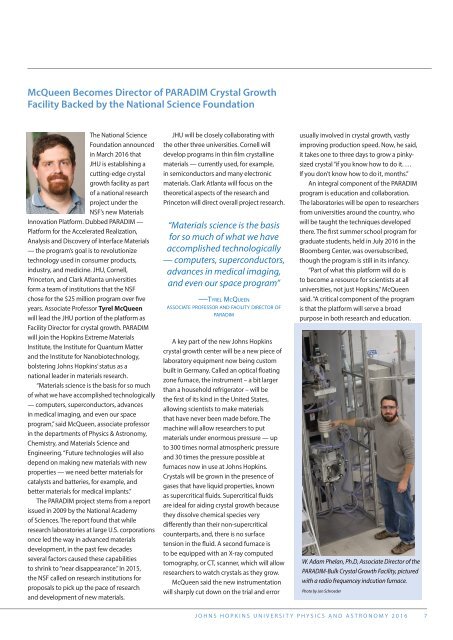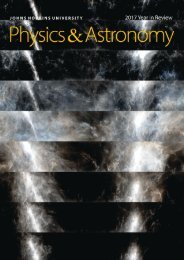2016_PA_Newsletter_12_29_16_FINAL
Create successful ePaper yourself
Turn your PDF publications into a flip-book with our unique Google optimized e-Paper software.
McQueen Becomes Director of <strong>PA</strong>RADIM Crystal Growth<br />
Facility Backed by the National Science Foundation<br />
The National Science<br />
Foundation announced<br />
in March <strong>20<strong>16</strong></strong> that<br />
JHU is establishing a<br />
cutting-edge crystal<br />
growth facility as part<br />
of a national research<br />
project under the<br />
NSF’s new Materials<br />
Innovation Platform. Dubbed <strong>PA</strong>RADIM —<br />
Platform for the Accelerated Realization,<br />
Analysis and Discovery of Interface Materials<br />
— the program’s goal is to revolutionize<br />
technology used in consumer products,<br />
industry, and medicine. JHU, Cornell,<br />
Princeton, and Clark Atlanta universities<br />
form a team of institutions that the NSF<br />
chose for the $25 million program over five<br />
years. Associate Professor Tyrel McQueen<br />
will lead the JHU portion of the platform as<br />
Facility Director for crystal growth. <strong>PA</strong>RADIM<br />
will join the Hopkins Extreme Materials<br />
Institute, the Institute for Quantum Matter<br />
and the Institute for Nanobiotechnology,<br />
bolstering Johns Hopkins’ status as a<br />
national leader in materials research.<br />
“Materials science is the basis for so much<br />
of what we have accomplished technologically<br />
— computers, superconductors, advances<br />
in medical imaging, and even our space<br />
program,” said McQueen, associate professor<br />
in the departments of Physics & Astronomy,<br />
Chemistry, and Materials Science and<br />
Engineering. “Future technologies will also<br />
depend on making new materials with new<br />
properties — we need better materials for<br />
catalysts and batteries, for example, and<br />
better materials for medical implants.”<br />
The <strong>PA</strong>RADIM project stems from a report<br />
issued in 2009 by the National Academy<br />
of Sciences. The report found that while<br />
research laboratories at large U.S. corporations<br />
once led the way in advanced materials<br />
development, in the past few decades<br />
several factors caused these capabilities<br />
to shrink to “near disappearance.” In 2015,<br />
the NSF called on research institutions for<br />
proposals to pick up the pace of research<br />
and development of new materials.<br />
JHU will be closely collaborating with<br />
the other three universities. Cornell will<br />
develop programs in thin film crystalline<br />
materials — currently used, for example,<br />
in semiconductors and many electronic<br />
materials. Clark Atlanta will focus on the<br />
theoretical aspects of the research and<br />
Princeton will direct overall project research.<br />
“Materials science is the basis<br />
for so much of what we have<br />
accomplished technologically<br />
— computers, superconductors,<br />
advances in medical imaging,<br />
and even our space program”<br />
—Tyrel McQueen<br />
associate professor and facility director of<br />
paradim<br />
A key part of the new Johns Hopkins<br />
crystal growth center will be a new piece of<br />
laboratory equipment now being custom<br />
built in Germany. Called an optical floating<br />
zone furnace, the instrument – a bit larger<br />
than a household refrigerator – will be<br />
the first of its kind in the United States,<br />
allowing scientists to make materials<br />
that have never been made before. The<br />
machine will allow researchers to put<br />
materials under enormous pressure — up<br />
to 300 times normal atmospheric pressure<br />
and 30 times the pressure possible at<br />
furnaces now in use at Johns Hopkins.<br />
Crystals will be grown in the presence of<br />
gases that have liquid properties, known<br />
as supercritical fluids. Supercritical fluids<br />
are ideal for aiding crystal growth because<br />
they dissolve chemical species very<br />
differently than their non-supercritical<br />
counterparts, and, there is no surface<br />
tension in the fluid. A second furnace is<br />
to be equipped with an X-ray computed<br />
tomography, or CT, scanner, which will allow<br />
researchers to watch crystals as they grow.<br />
McQueen said the new instrumentation<br />
will sharply cut down on the trial and error<br />
usually involved in crystal growth, vastly<br />
improving production speed. Now, he said,<br />
it takes one to three days to grow a pinkysized<br />
crystal “if you know how to do it. …<br />
If you don’t know how to do it, months.”<br />
An integral component of the <strong>PA</strong>RADIM<br />
program is education and collaboration.<br />
The laboratories will be open to researchers<br />
from universities around the country, who<br />
will be taught the techniques developed<br />
there. The first summer school program for<br />
graduate students, held in July <strong>20<strong>16</strong></strong> in the<br />
Bloomberg Center, was oversubscribed,<br />
though the program is still in its infancy.<br />
“Part of what this platform will do is<br />
to become a resource for scientists at all<br />
universities, not just Hopkins,” McQueen<br />
said. “A critical component of the program<br />
is that the platform will serve a broad<br />
purpose in both research and education.<br />
W. Adam Phelan, Ph.D, Associate Director of the<br />
<strong>PA</strong>RADIM-Bulk Crystal Growth Facility, pictured<br />
with a radio frequencey indcution furnace.<br />
Photo by Jon Schroeder<br />
JOHNS HOPKINS UNIVERSITY PHYSICS AND ASTRONOMY <strong>20<strong>16</strong></strong> 7










